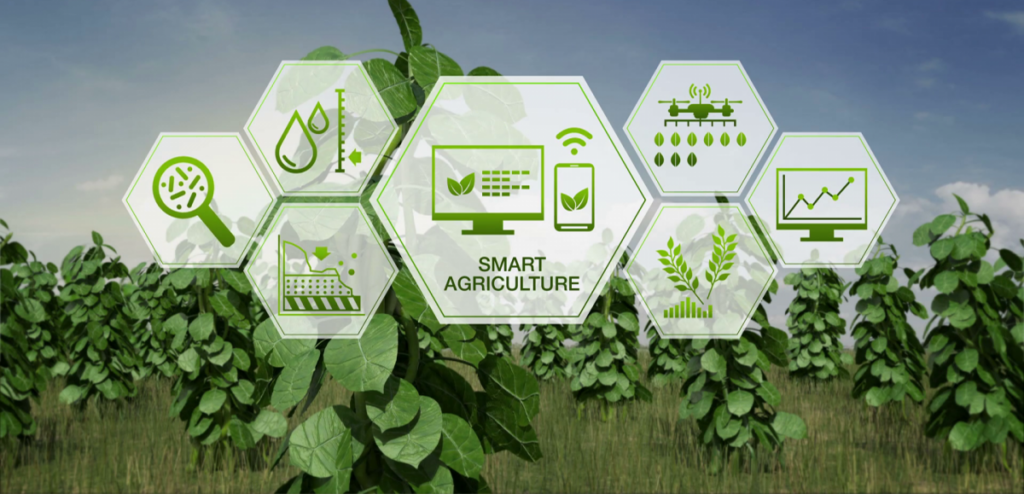Table of Contents
Internet of things (IoT) more and more penetrates our lives through health and fitness, home automation, automotive and smart cities. Therefore, it becomes evident that the IoT, connected devices, will also be actively used in agriculture and agricultural mapping software, improving its work in all aspects. The industry can’t rely on horses and hand harvester tools anymore because self-driving cars and virtual reality are no longer science fiction, but a common occurrence.
Many technological transformations happened with farming over the last decade or two; that is why it became more industrialized and technology-driven. Thanks to the usage of smart agricultural devices, farmers gained more control over the process of sowing and growing crops. This approach allowed to make yields more predictable and enhance quality.
The growing demand for agriculture products has led to increased implementation of smart farming technologies worldwide. In 2021, the market share for IoT in agriculture reached $5.6 billion and IoT application development is becoming more popular.
What is Smart Agriculture? (the definition and market size)
There are many ways how to call modern agriculture. For example, AgriTech can be used for the application of technology in agriculture in general.
However, smart agriculture is widely used to describe the application of IoT solutions in agriculture. So how does smart agriculture use IoT? IoT sensors usage allows farmers to collect environmental and machine metrics and make well-informed decisions, and improve their work – from livestock to crop farming.
For example, smart agriculture sensors to monitor crops provide data to farmers to define precisely how many pesticides, and fertilizers should be used to reach optimal efficiency. The same definition we can apply to smart farming.
Smart agriculture IoT is not yet in high demand as consumer-connected devices, but the market is still dynamic.
The adoption of IoT solutions for agriculture is continuously growing. Disruptions of the supply chain and the shortage of qualified workers caused by the economic crisis at the beginning of this year increased its CAGR to 9,9%. In fact, as per recent reports, the smart framing market share will reach $6.2 billion by 2021.
Meanwhile, we expect that the global smart agriculture market size will triple by 2025, reaching $15.3 billion.
As the market is still growing, there is still great potential for businesses. Building IoT products for agriculture during the next two years can distinguish you as one of the pioneers and lead to success.
Why this prospect of building an IoT application for agriculture is so appealing?
The Benefits of Smart Farming
Technologies and IoT can bring a lot of positive changes in many sectors of agriculture. We are going to highlight 5 ways of improvement by IoT:
- Data, tons of data, collected by smart agriculture sensors, like weather conditions, soil quality, crop’s growth progress, or cattle’s health. The data analysis can help you monitor the state of the business as well as staff performance, equipment efficiency, etc.
- Better keeping the internal processes under control and, reduce possible production risks. If you know the output of your production, you will be able to plan better the distribution of your products. The precise understanding of crop area allows you to be sure that crops will not be spoiled or unsold.
- Control over production enables you to reduce cost management and waste reduction. The technology can detect damage to grains at an early stage, thereby reducing the risk of yield loss.
- Automation of processes will increase the efficiency of your business. Smart devices can automate your production cycle processes, such as irrigation, fertilizing, or pest control.
- Increase product quality and volume. Automation allows your business to better monitor the production process, maintain higher standards of crop quality, and build productive capacities.
After all, these factors can lead you to the most desired result – higher revenue.
Now, after such promising benefits of IoT usage in the agriculture sectors, let’s look at how all these can work in real life.
Examples of how IoT can be applied in Agriculture
There are different types of IoT sensors for agriculture along with IoT applications in agriculture in general:
- Precision farming. Precision farming is responsible for efficiency and making data-driven decisions. These are commonly used IoT applications in agriculture. Farmers via IoT sensors can gather a great variety of metrics on every indicator of the field microclimate and ecosystem: temperature, soil condition, CO2 levels, and pest infections. Using the information, farmers can decide about the required amounts of water, fertilizers, and pesticides. It helps to avoid resource overruns, reduce expenses, and grow better and healthier plants.
- Greenhouse automation. Farmers usually use manual adjustment of the greenhouse environment. Using IoT gives them real-time information on greenhouse conditions such as lighting, temperature, soil condition, and humidity. Furthermore, weather stations can automatically adjust the conditions to match the given parameters, and greenhouse systems use the same method.
- Cattle monitoring and management. Like crop monitoring, IoT agriculture sensors can be applied to farm animals for monitoring their health and log performance. Livestock tracking and monitoring help collect data on stock health, well-being, and physical location.
- Monitoring of climate conditions. The most widely used smart devices in agriculture are weather stations with different smart farming sensors. Usually, they are placed all over the field; they gather data from the environment and send it to the cloud. Farmers use the provided measurements to map the climate conditions, choose the particular crops, and take the required measures to improve their capacity.
- Crop management. Crop management devices are IoT products that are the elements of precision farming. Like weather stations, for collecting data related to crop farming, IoT devices are placed across the field: from temperature and precipitation to leaf water potential and overall crop health.
FAQ
- Sensors for soil scanning, water, light, humidity, temperature management;
- Software applications — software solutions that aim to solve specific farm issues;
- Communication technologies, such as cellular communication;
Analysis of information that helps to make a decision and prediction processes. IoT smart farming is more efficient than the conventional approach.
- Data, tons of data, collected by smart agriculture sensors. The data analysis can help you monitor the state of the business as well as staff performance, equipment efficiency, etc.
- Better keeping the internal processes under control and, reduce possible production risks. If you know the output of your production, you will be able to plan better the distribution of your products.
- Control over production enables you to reduce cost management and waste reduction.
- Automation of processes will increase the efficiency of your business. Smart devices can automate your production cycle processes, such as irrigation, fertilizing, or pest control.
- Increase product quality and volume. Automation allows your business to better monitor the production process, maintain higher standards of crop quality, etc.
After all, these factors can lead you to the most desired result – higher revenue.
- Location Sensors These sensors determine latitude, longitude, and altitude of any position within the required area. They can use GPS satellites for this purpose.
- Optical Sensors These sensors use light to measure the properties of the soil. They are installed on satellites, drones, or robots to determine clay, organic matter, and soil moisture contents.
- Electro-Chemical Sensors These sensors gather chemical data of the soils by detecting specific ions in the ground. They provide pieces of information in the form of pH and soil nutrient levels.
- Mechanical Sensors These sensors are used to measure soil compaction or mechanical resistance.
- Dielectric Soil Moisture Sensors These sensors measure moisture levels by measuring the dielectric constant of the soil.
- Air Flow Sensors These sensors are used to measure air permeability. They are used in a fixed position or mobile mode.
IoT agricultural applications are making it possible for farmers to collect useful data. Big landowners and small farmers must understand the potential of the IoT market for agriculture by installing smart technologies to increase competitiveness and sustainability in their productions. With the population overgrowing, the demand can be met if the farmers implement agricultural IoT solutions in the nearest future.






